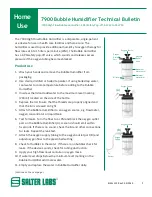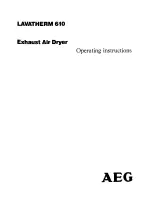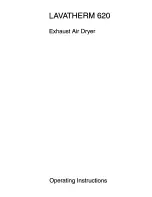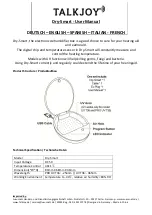
IMPORTANT SAFEGUARDS
READ BEFORE USING YOUR HUMIDIFIER
1) This appliance has a polarized plug (one blade is wider than the other). To reduce the risk of electric shock, this plug is
intended to fit into a polarized 120-volt AC, 15 amp outlet, and only one way. If the plug does not fit fully in the outlet,
reverse the plug. If it still does not fit, contact a qualified electrician. Do not attempt to defeat this safety feature. If an
extension cord must be used, it should also accept the wide blade plug and meet this electrical rating.
2) Do not place the cord under rugs, near loose drapes, in traffic areas, nor near heat sources or combustible materials.
3) Do not use the humidifier if the cord is damaged.
4) Always unplug the power cord before filling, cleaning, servicing, or when the unit is not in use.
5) This humidifier is UL listed with Essick Air brand evaporative wicks in place. To maintain your UL rating, see your service
center for all repairs.
6) Regular cleaning is recommended. Refer to the CARE & MAINTENANCE section in the manual.
INTRODUCTION
Your Essick Air evaporative humidifier adds invisible moisture to your home by moving dry inlet air through a saturated
wick. As air moves through the wick, the water evaporates into the air, leaving behind any white dust, minerals, or dissolved
and suspended solids. Because the water is evaporated, there is just clean and invisible moist air.
As the evaporative wick traps accumulated minerals from the water, its ability to absorb and evaporate water decreases.
We recommend changing the wick at the beginning of every season. In hard water areas, more frequent replacement may be
necessary to maintain your humidifier’s efficiency.
Use only Essick Air brand replacement wicks and chemicals. To order parts, wicks and chemicals call 1-800-547-3888.
The H12 Series humidifiers use Essick Air wick # 1045. Only the Essick Air evaporative wick guarantees the certified output of
your humidifier. Use of wicks other than Essick Air brand will void your warranty as well as the certification of output and may
reduce the output of your humidifier.
Dry air is drawn into the humidifier through the back and moisturized as it passes through the evaporative wick. It is then
fanned out into the room.
1) Water bottle
2) Chassis/Power Pack
(motor and fan assembly)
3) Evaporative
wick
4) Water
reservoir
5) Dry room air intake
6) Moist air output
CAUTION: Do NOT position the unit directly in front of a hot air duct or
radiator. Do NOT place on soft carpet.
ASSEMBLY, CONTROLS & OPERATION
1) Remove the two polyfoam inserts from the top of the humidifier.
2) Lift off the water bottle cover (left-hand side). Remove the water bottle, lift off the chassis/power pack and then remove the
humidifier cabinet from the carton.
3) Remove the evaporative wick, float assembly (black rod with white float), and all of the remaining packaging materials from
the cabinet. Check to see that you have all of the following items removed from the boxes accessory kit and cabinet
before discarding the packaging:
o
Filler
hose
o
Caster
kit
o
Bacterial treatment sample
o
Water bottle with cap
o
Optional AirCare Filter (purchased separately)
IMPORTANT FILLING INFORMATION
4) Your humidifier is equipped with one water bottle. When both the water bottle and reservoir have emptied, the humidifier
fan will automatically shut off, but will start again automatically when the water bottle and reservoir are refilled.
5) When the bottle is being filled for the first time and the wick is still dry, it will take approximately 20 minutes to drain the
bottle into the reservoir. After the bottle has emptied, it should be refilled again to obtain maximum running time.
6) When refilling the bottle and the wick is still wet, it will take approximately 12 minutes to refill the reservoir. At this time,
you should refill the bottle for maximum running time.
CASTERS
7) Turn the emptied cabinet upside down. Insert each caster stem into the four caster holes on each corner of the humidifier
bottom. The casters should fit snugly and be inserted until the stem shoulder reaches the cabinet surface. Do not
force.






















